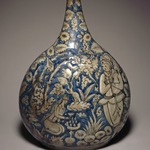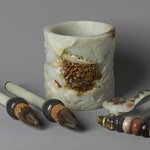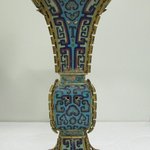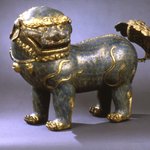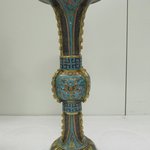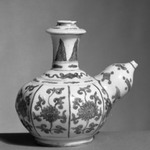Could you tell me more about this please?

Absolutely! This large and elaborate incense burner was likely made for a Buddhist temple in Qing-dynasty China during the reign of the Qianlong Emperor. The shape reflects an ancient Chinese ritual vessel, a cauldron-like bronze with three legs.
It would have originally been part of a set of five vessels, one incense burner (here), two candlesticks and two vases, which would have been placed in front of an altar/shrine
in a Buddhist temple.
The vessel is covered in auspicious and symbolic motifs. The red characters along the lid, which is where the smoke would have exited from, are "shou," which means longevity. There are also a number of lotus flowers, which are a popular Buddhist motif.
What's champleve enamel?

Champleve enamel is a process in which gouges are made into a metal base and enamel poured in. It means "raised fields."
This incense burner features two different techniques of enamel: cloisonne and champleve. You can find the champleve sections on the top of the handles (the motif there is bats--bats are an auspicious motif since the word for "bat" is similar to the word for "good luck"!).
Does the Tripod Censer have a purpose other than decoration?
Yes, it does. While a large function of this tripod censer was its beauty and a sign of wealth, it is a functioning incense burner. It would have been used in a Buddhist Temple context in 18th century China.
What is this made out of?

This incense burner is made of metal and enamel. The enamel is poured into small cells on a bronze body, creating the colorful final product here.
If you look closely, you can see the golden wires that separate each color of enamel. These cells are why the technique is called "cloisonné."
How old is the piece?

The work dates to the late 18th century, during the reign of the Qianlong emperor in China.
How was this used?

This cloisonné vessel is an incense burner for use in a Buddhist temple or shrine space, which explains why it is so large and decorative. The top of the vessel opens and incense would have been placed inside.
If you look closely, you can find the small holes, shaped like the character for long life, where the smoke would come out.
Thank you!
This is amazing! What was it used for?

This was used as an incense burner! The incense would be placed inside, and the smoke would come out through the decorative holes along the top. It would have been placed in a Buddhist temple, as part of a set of objects placed in front of the main worship space.
How was this used?

This incense burner comes from the reign of the Qianlong emperor in China during the 17th century. It is made using the cloisonne enamel technique. The incense would have been placed inside the body of the vessel and the smoke would come out of the holes along the top of the lid. It would have been used in a Buddhist temple or shrine space.
What is this symbol?

The symbol you've picked out is called the "shou" character. Shou stands for longevity. When lit, this incense burner would emit the incense through the open sections of the shou characters. In the Infinite Blue exhibition there is also a small incense burner, of the same shape, made of solid lapis lazuli. I recommend taking a look, they're so different in size and material, it's fascinating!
What is it?

A tripod censer is a three-legged incense burner. You may be able to see where the top would open up, allowing bricks of incense to be placed inside. The scented smoke would then have come out of the round designs at the top of the censer. The round design in red is the character "shou" which means "long life" in Chinese.
Que servicio tenía

Es un incensario, hecho probablemente para un templo budista. El humo habría salido de las aberturas rojas en la tapa. Están en la forma del carácter chino para longevidad.
What is a censer?

A censer is used to burn incense. A brick of incense would be placed inside the body of the vessel and then lit, or else sticks of incense would be placed in the vessel. Smoke would emerge from the red circular vents in the lid which are in the shape of the Chinese character for the word “longevity.”
What is this symbol on the tripod?

The symbols on the tripod are "shou" symbols, and they stand for longevity!
Thanks for the above!
Can you tell me what the red circle symbol means?

This red symbol is the Chinese character "shou." It means longevity which was (and is) an important concept in Chinese culture so it, understandably, is integrated into Chinese art.
Symbols of good luck and prosperity are common in Chinese art. For instance, on the body of this censer you can see the "shou" symbol again surrounded by bats. The word for bat in Chinese, “fu,” is a homophone for the character for good luck and good fortune.
That's really interesting!
We are curious about the labyrinthine patterns.

Those patterns with holes in them at the top of this incense burner are "shou" characters. They translate to "longevity" in English. Those symbols have holes in them because that's where the smoke comes out when the incense are burned inside the censer!
Wow, thank you!
Can you tell me more about where this came from?

Of course! It comes from the reign of the Qianlong emperor in China, during which many large ritual cloisonne vessels, like this incense burner, were created for Buddhist temples.
The shape actually recalls an even earlier Chinese vessel shape: the "ding." The shape can be traced back to the 12th century B.C.E.!
Is this bronze?

No. It's based on an archaic bronze shape but the vessel itself is made using the cloisonne enamel technique on a copper base form.
It's huge! What part of China is this from?

We don't know exactly which part of the country this comes from. Cloisonné was first brought to China from the Middle East and was initially produced in Yunnan in the 13th century, but the art form quickly spread to the rest of China.
Thank you for the information. I am visiting with a friend from Wuhan, China and he was curious.
What was this used for?

This was used for burning incense! A brick or bricks of incense would be placed in the body of the vessel and lit. The smoke would escape from those red, circle shaped vents on the top.
A brick?!
Yes! But perhaps a bit smaller than the brick you're thinking of. More like, palm sized.
Would this be in people's homes?

This was one of a set of 5 typical ritual objects that would be placed on a shrine in a Buddhist temple!
The process of making cloisonné is very complicated, how long would it take to make this entire piece? Are there examples of even larger cloisonné pieces?

There is effectively no limit to the size of a cloisonné object since one piece can be enameled in sections and assembled later. I'm not sure quite how long it would take, but there are some nearby plaques that help illustrate all of the necessary steps!
It doesn't look like we have any notes of how long the process would be for a piece this size. I imagine in a workshop setting it would probably be around several weeks.
We like the rigid line symbols framed by the loose flower pattern

That sign is "shou" which means longevity.
You'll notice that the same symbol is used in the holes to allow incense smoke to escape in the lid.
Would this just be for decoration or does it have a use?

It most definitely is functional. Although elaborately decorated, it is a functioning incense burner. It would have been used in a Buddhist Temple context in 18th century China.
The top of the vessel opens and incense would have been placed inside.
Ah that is cool, thank you







































